- Accueil
- Pages cachées
- 20 FEVRIER 2024 NEWS
20 FEVRIER 2024 NEWS
INSTITUT SUPERIEUR D'ANTHROPOLOGIE
INSTITUTE OF ANTHROPOLOGY
ONLINE COURSES / COURS A DISTANCE
INSCRIPTIONS OUVERTES
REGISTER NOW
SUISSE – 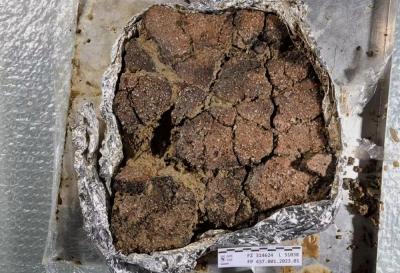
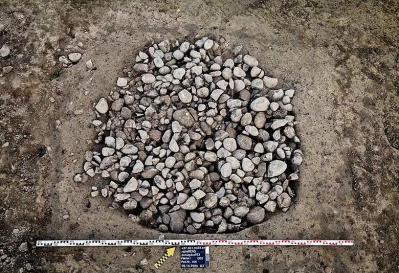 Heimberg - In advance of a construction project in Heimberg, the Archaeological Service of the Canton of Bern carried out a rescue excavation in autumn 2023. Although the investigation yielded hardly any new findings about an expected Roman site, it did reveal the remains of a previously unknown settlement from the Bronze Age. During the investigation at the Schulgässli in Heimberg, which lasted a good three months, various settlement remains were documented on almost 1000 m²: in addition to a usage horizon with a very high proportion of heat stones and (relatively) a lot of Bronze Age ceramics, also various post positions and pits. Two of these pits were filled to the brim with heat stones, i.e. stones that had been shattered by great heat. These could have been used as heat storage in cooking or heating pits and represent a typical finding for the Bronze Age. Other pits may have been used to extract clay. At that time, clay was an important raw material and was used, for example, to plaster the wicker walls of houses or to produce pottery. This is matched by an up to 35 m thick layer package of hillside clay in the excavation area. escue excavations in Thun-Schoren, Richigen, and Kehrsatz/Chlywabere have also uncovered extensive Bronze Age settlement remains. The new Bronze Age sites demonstrate the importance of the Aare Valley as a habitat and transport route between the Alps (passes) and the Swiss Plateau.
Heimberg - In advance of a construction project in Heimberg, the Archaeological Service of the Canton of Bern carried out a rescue excavation in autumn 2023. Although the investigation yielded hardly any new findings about an expected Roman site, it did reveal the remains of a previously unknown settlement from the Bronze Age. During the investigation at the Schulgässli in Heimberg, which lasted a good three months, various settlement remains were documented on almost 1000 m²: in addition to a usage horizon with a very high proportion of heat stones and (relatively) a lot of Bronze Age ceramics, also various post positions and pits. Two of these pits were filled to the brim with heat stones, i.e. stones that had been shattered by great heat. These could have been used as heat storage in cooking or heating pits and represent a typical finding for the Bronze Age. Other pits may have been used to extract clay. At that time, clay was an important raw material and was used, for example, to plaster the wicker walls of houses or to produce pottery. This is matched by an up to 35 m thick layer package of hillside clay in the excavation area. escue excavations in Thun-Schoren, Richigen, and Kehrsatz/Chlywabere have also uncovered extensive Bronze Age settlement remains. The new Bronze Age sites demonstrate the importance of the Aare Valley as a habitat and transport route between the Alps (passes) and the Swiss Plateau.
https://arkeonews.net/a-previously-unknown-bronze-age-settlement-discovered-in-switzerland/
POLOGNE – 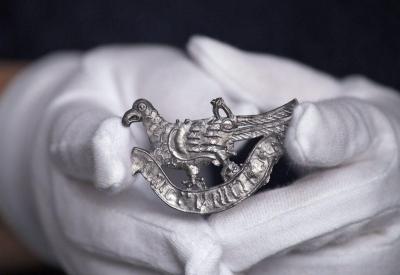 The Crane - Polish archaeologists have discovered a late medieval badge: a piece of tin shaped into a turtle dover and with the Latin inscription: “AMOR VINCIT OMNIA” – “Love conquers all”. The turtle dove badge includes the remains of two detached handles that would allow it to be hanged from a chain or attached to clothing. To early Greeks and Romans, doves symbolized love, devotion, and caring. The dove was the sacred animal of Aphrodite and Venus the goddesses of love. When you think of birds and love, a pair of doves is probably the most likely image that springs to mind. Their reputation as symbols of love is so strong that many love potion recipes popular during medieval times required the heart of a dove. The museum said that similar ornaments were popular in Gdańsk between the 14th and 15th centuries and that this fashion came from Western Europe, especially from the Netherlands and England. The artifact was discovered during archaeological work at The Crane, a 15th-century port crane sandwiched between two defensive towers. The original structure, which was first mentioned in 1367, burned down in 1442 before its current design was created between 1442 and 1444. As a working crane, it was used to transfer cargo and raise ship masts. This was once the world’s largest working crane, but it also served as a defensive structure and one of the city’s gates. It had a lifting capacity of 4 tonnes to a height of 11 meters, which was achieved by two massive wooden wheels at its heart, each with a diameter of 6 meters.,Since 2020, restoration efforts have been underway to restore The Crane,
The Crane - Polish archaeologists have discovered a late medieval badge: a piece of tin shaped into a turtle dover and with the Latin inscription: “AMOR VINCIT OMNIA” – “Love conquers all”. The turtle dove badge includes the remains of two detached handles that would allow it to be hanged from a chain or attached to clothing. To early Greeks and Romans, doves symbolized love, devotion, and caring. The dove was the sacred animal of Aphrodite and Venus the goddesses of love. When you think of birds and love, a pair of doves is probably the most likely image that springs to mind. Their reputation as symbols of love is so strong that many love potion recipes popular during medieval times required the heart of a dove. The museum said that similar ornaments were popular in Gdańsk between the 14th and 15th centuries and that this fashion came from Western Europe, especially from the Netherlands and England. The artifact was discovered during archaeological work at The Crane, a 15th-century port crane sandwiched between two defensive towers. The original structure, which was first mentioned in 1367, burned down in 1442 before its current design was created between 1442 and 1444. As a working crane, it was used to transfer cargo and raise ship masts. This was once the world’s largest working crane, but it also served as a defensive structure and one of the city’s gates. It had a lifting capacity of 4 tonnes to a height of 11 meters, which was achieved by two massive wooden wheels at its heart, each with a diameter of 6 meters.,Since 2020, restoration efforts have been underway to restore The Crane,
https://arkeonews.net/medieval-love-badge-with-the-written-love-conquers-all-discovered-in-poland/
FRANCE –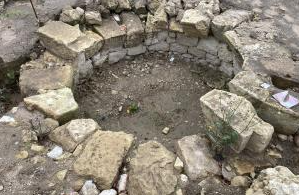 Beaumont - C’est la première fois, en Europe, que l’on fouille en une seule fois tout l’espace d’une abbaye : l’église, le cloître, les jardins, les cimetières, le mur d’enceinte, et ce, depuis les origines, de la fondation de l’abbaye en 1002, jusqu’en 1790, au moment où les bénédictines en sont chassées. La fouille a aussi mis au jour des vestiges plus anciens du village de Beaumont datant des IXe-Xe siècle, situés sous l’abbaye. En ce qui concerne l’église de l’abbaye, nous avons pour l’heure distingué trois états. Il y a une première église assez courte (23 m) à chevet plat, qui est peut-être la petite chapelle que je viens d’évoquer, mais que nous avons encore des difficultés à dater de manière fine. Il existe au moins un bâtiment au sud de ce lieu de culte. Lui succède aux environs du XIe/XIIe siècle une église, de cinquante-deux mètres de long avec un chevet en abside flanqué de deux chapelles absidioles. Un cloître au sud, flanqué de ses bâtiments périphériques (dont la salle capitulaire dans l’aile est) est présent. Enfin, au XIIe-XIIIe siècle, on ajoute à l’église un déambulatoire, ce qui porte à 55 m la longueur totale de l’édifice. C’est un site qui a connu 800 ans d’évolution. Par exemple, concernant l’aile est du cloître, nous avons mis en évidence trois états qui correspondent plutôt à des agrandissements qu’à des remises à plat. Parfois, le sol s’affaisse. Ils les refont en mettant du remblai – de 10 centimètres à 30 centimètres – et en profitent pour agrandir une pièce. Nous avons identifié quatre à cinq sols, parfois carrelés. Ils ajoutent des pièces, refont des carrelages, rajoutent des toilettes. Ils modifient sans arrêt. Cela peut surprendre, mais cela suit la même logique que nos maisons dont on refait tous les vingt ans la cuisine, si ce n’est que cela a duré huit siècles. Il est donc normal d’avoir autant de modifications affectant les sols et les cloisons. C’est dans cette aile est que l’on trouve, connectée à l’église par une petite pièce, la salle capitulaire, certainement présente dès le XIIe siècle et qui se maintient jusqu’à la Révolution.
Beaumont - C’est la première fois, en Europe, que l’on fouille en une seule fois tout l’espace d’une abbaye : l’église, le cloître, les jardins, les cimetières, le mur d’enceinte, et ce, depuis les origines, de la fondation de l’abbaye en 1002, jusqu’en 1790, au moment où les bénédictines en sont chassées. La fouille a aussi mis au jour des vestiges plus anciens du village de Beaumont datant des IXe-Xe siècle, situés sous l’abbaye. En ce qui concerne l’église de l’abbaye, nous avons pour l’heure distingué trois états. Il y a une première église assez courte (23 m) à chevet plat, qui est peut-être la petite chapelle que je viens d’évoquer, mais que nous avons encore des difficultés à dater de manière fine. Il existe au moins un bâtiment au sud de ce lieu de culte. Lui succède aux environs du XIe/XIIe siècle une église, de cinquante-deux mètres de long avec un chevet en abside flanqué de deux chapelles absidioles. Un cloître au sud, flanqué de ses bâtiments périphériques (dont la salle capitulaire dans l’aile est) est présent. Enfin, au XIIe-XIIIe siècle, on ajoute à l’église un déambulatoire, ce qui porte à 55 m la longueur totale de l’édifice. C’est un site qui a connu 800 ans d’évolution. Par exemple, concernant l’aile est du cloître, nous avons mis en évidence trois états qui correspondent plutôt à des agrandissements qu’à des remises à plat. Parfois, le sol s’affaisse. Ils les refont en mettant du remblai – de 10 centimètres à 30 centimètres – et en profitent pour agrandir une pièce. Nous avons identifié quatre à cinq sols, parfois carrelés. Ils ajoutent des pièces, refont des carrelages, rajoutent des toilettes. Ils modifient sans arrêt. Cela peut surprendre, mais cela suit la même logique que nos maisons dont on refait tous les vingt ans la cuisine, si ce n’est que cela a duré huit siècles. Il est donc normal d’avoir autant de modifications affectant les sols et les cloisons. C’est dans cette aile est que l’on trouve, connectée à l’église par une petite pièce, la salle capitulaire, certainement présente dès le XIIe siècle et qui se maintient jusqu’à la Révolution.
https://www.inrap.fr/l-abbaye-de-beaumont-fouillee-dans-son-integralite-indre-et-loire-17815#
USA – St. Mary - Researchers at Historic St. Mary’s City dug up a tasset, a metal piece that extended down from a breastplate to protect a fighter’s thighs. Archeologists were not sure the historic fort even existed until 2021. That’s when an outline of it was discovered in the dirt. Then they started finding other things. According to The Washington Post, a teenage skeleton was recovered in March 2023, along with a metal braid and a pair of scissors. Archeologists believe Historic St. Mary’s City was built In 1634 by some of the first European settlers in Maryland. It’s located south of the current St. Mary’s City, the first colonial capital. The tasset was found in a cellar area, which became a trash pit. That’s led researchers to think it was tossed aside as an antiquated item for military use. “They’re heavy. It’s a hot, humid environment,” Parno explained. “You keep your breastplate, though, because that’s protecting your core.”But metal was common for soldiers of the 17th century. Metal breastplates and helmets have been found in Jamestown, Virginia, one of the first colonial settlements. The next big thing for the Historic St. Mary’s City researchers is digging up some kind of a large building on the fort site. They’ve found the outline of it. “Was it somebody’s home? Was it a public building?” Parno wonders. “Did it have a religious function? A civic function? A military function?” Parno added that the fort appears to have about a dozen additional buildings, waiting to be excavated and studied. The researchers have records indicating the ships Arc and Dove brought the first settlers from Britain to the colonies in 1634. But there’s no record of the fort existing beyond 1642.
https://knewz.com/tasset-armor-archeology-saint-marys-maryland/
TAIWAN – 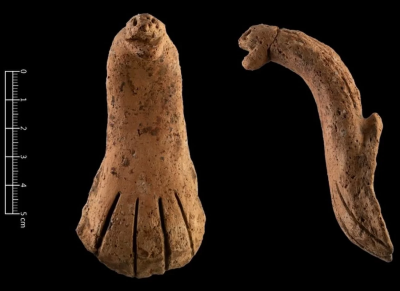 Taoyuan -National Tsing Hua University archaeologists in Taiwan have discovered a snake-shaped pottery handle dating back approximately 4000 years. Researchers uncovered the find at a sand dune site on the island’s northwest coast, located within the Guanyin District in western Taoyuan City. Crafted in the shape of a cobra with its upper body raised and hood flattened ready to strike, this item may have served as a type of handle for a larger item, such as a vessel or ceremonial jar. The figure is characterized by its raised head with an open mouth and swollen folds on the neck, which are important features of a cobra snake. The researchers determined the age of the snake-shaped artifact using radiocarbon dating techniques, noting that it was approximately 4,000 years old. This snake-shaped clay piece could be interpreted as a ceremonial instrument used by ancient tribe shamans to perform rituals, illustrating how animal imagery was incorporated into ceremonial instruments in ancient societies, shaping their belief systems and knowledge. Also, numerous prehistoric archeological artifacts from Taiwan have been discovered at the coastal location. Among them is a recently found area of extensive stone tool processing, according to Hung-Lin Chiu, an associate professor at Tsing Hua’s Institute of Anthropology. In this region, several stone flakes and cores have been discovered.
Taoyuan -National Tsing Hua University archaeologists in Taiwan have discovered a snake-shaped pottery handle dating back approximately 4000 years. Researchers uncovered the find at a sand dune site on the island’s northwest coast, located within the Guanyin District in western Taoyuan City. Crafted in the shape of a cobra with its upper body raised and hood flattened ready to strike, this item may have served as a type of handle for a larger item, such as a vessel or ceremonial jar. The figure is characterized by its raised head with an open mouth and swollen folds on the neck, which are important features of a cobra snake. The researchers determined the age of the snake-shaped artifact using radiocarbon dating techniques, noting that it was approximately 4,000 years old. This snake-shaped clay piece could be interpreted as a ceremonial instrument used by ancient tribe shamans to perform rituals, illustrating how animal imagery was incorporated into ceremonial instruments in ancient societies, shaping their belief systems and knowledge. Also, numerous prehistoric archeological artifacts from Taiwan have been discovered at the coastal location. Among them is a recently found area of extensive stone tool processing, according to Hung-Lin Chiu, an associate professor at Tsing Hua’s Institute of Anthropology. In this region, several stone flakes and cores have been discovered.
https://arkeonews.net/4000-year-old-snake-shaped-pottery-handle-found-in-taiwan/
ESPAGNE – 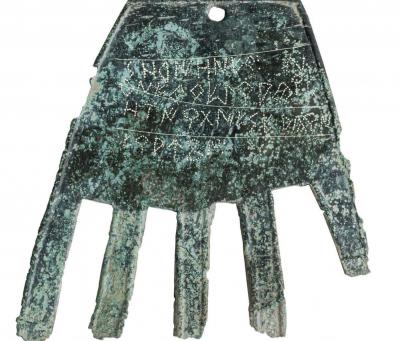 Aranguren -Researchers have discovered rare evidence of an enigmatic ancient language on a 2,000-year-old bronze hand. The inscription on the hand is the oldest and longest known example of Vasconic. Its detailed linguistic analysis suggests that the script represents a graphic subsystem of Palaeohispanic that has roots in the modern Basque language and is the first example of Vasconic epigraphy. Archaeologists discovered the bronze hand in 2021 at the Irulegi archaeological site near the Aranguren Valley in Spain’s northern Navarre region, about 8 km from modern-day Pamplona. Researchers got to work excavating the hillock, on which the walls of a medieval castle also stand. At the foot of the fortification, the remains of a 2,000-year-old settlement were uncovered. On the threshold of one of the homes destroyed during the Sertorian Wars, workers found a bronze slab in 2021 that was roughly 14.5 centimeters (5.7 in) long and shaped like a hand. Laboratory analysis revealed that strange inscriptions were engraved on its fingers, in the form of 40 symbols distributed across four lines. It consisted of a sheet of bronze, cut to represent the shape of a life-sized right hand.The text inscribed on this artifact, which was found at the entrance of a domestic building, is interpreted as apotropaic, a token entreating good fortune. Researchers analyzed the artifact, northern Spain, for a newly published study in the journal Antiquity—and also suggested the words written on it could be linked to modern-day Basque. This connection is supported by the identification of the Basque term for ‘good fortune’ on the artifact. Vasconic was spoken by the Vascones, a pre-Roman people who lived in the western Pyrenees, primarily in what is now Navarre, as well as parts of the Spanish regions of La Rioja and Aragon. Due to the comparatively small number of pre-Roman writing samples found in the areas the Vascones once called home, it was previously believed that these people lived in a preliterate society. However, the most recent study’s findings support a developing body of evidence suggesting that the ancient Vascones were at least somewhat familiar with and used writing, undermining this theory. One word is sufficiently similar to Basque to be considered a “cognate,” a term that suggests a possible connection, even though it is the only lengthy Vasconic text that has been found to date. “The discovery of the Hand of Irulegi has opened a new horizon to unravel the history behind the most enigmatic language still alive in Europe: the Basque language,” Mikel Edeso Egia from the Aranzadi Science Society—a non-profit organization based in Spain’s Basque region that coordinated the research team—said in a press release. “The Irulegi hand must be considered as a well-integrated element within the cultural context of the settlement,” the study’s lead author, Mattin Aiestaran with the University of the Basque Country, said. “The hand would have had a ritual function, either to attract good luck or as an offering to an indigenous god or goddess of fortune.” However, “the lack of other comparative texts makes it difficult to prove a direct link between the Vasconic language spoken at Irulegi and the present-day Basque language.”
Aranguren -Researchers have discovered rare evidence of an enigmatic ancient language on a 2,000-year-old bronze hand. The inscription on the hand is the oldest and longest known example of Vasconic. Its detailed linguistic analysis suggests that the script represents a graphic subsystem of Palaeohispanic that has roots in the modern Basque language and is the first example of Vasconic epigraphy. Archaeologists discovered the bronze hand in 2021 at the Irulegi archaeological site near the Aranguren Valley in Spain’s northern Navarre region, about 8 km from modern-day Pamplona. Researchers got to work excavating the hillock, on which the walls of a medieval castle also stand. At the foot of the fortification, the remains of a 2,000-year-old settlement were uncovered. On the threshold of one of the homes destroyed during the Sertorian Wars, workers found a bronze slab in 2021 that was roughly 14.5 centimeters (5.7 in) long and shaped like a hand. Laboratory analysis revealed that strange inscriptions were engraved on its fingers, in the form of 40 symbols distributed across four lines. It consisted of a sheet of bronze, cut to represent the shape of a life-sized right hand.The text inscribed on this artifact, which was found at the entrance of a domestic building, is interpreted as apotropaic, a token entreating good fortune. Researchers analyzed the artifact, northern Spain, for a newly published study in the journal Antiquity—and also suggested the words written on it could be linked to modern-day Basque. This connection is supported by the identification of the Basque term for ‘good fortune’ on the artifact. Vasconic was spoken by the Vascones, a pre-Roman people who lived in the western Pyrenees, primarily in what is now Navarre, as well as parts of the Spanish regions of La Rioja and Aragon. Due to the comparatively small number of pre-Roman writing samples found in the areas the Vascones once called home, it was previously believed that these people lived in a preliterate society. However, the most recent study’s findings support a developing body of evidence suggesting that the ancient Vascones were at least somewhat familiar with and used writing, undermining this theory. One word is sufficiently similar to Basque to be considered a “cognate,” a term that suggests a possible connection, even though it is the only lengthy Vasconic text that has been found to date. “The discovery of the Hand of Irulegi has opened a new horizon to unravel the history behind the most enigmatic language still alive in Europe: the Basque language,” Mikel Edeso Egia from the Aranzadi Science Society—a non-profit organization based in Spain’s Basque region that coordinated the research team—said in a press release. “The Irulegi hand must be considered as a well-integrated element within the cultural context of the settlement,” the study’s lead author, Mattin Aiestaran with the University of the Basque Country, said. “The hand would have had a ritual function, either to attract good luck or as an offering to an indigenous god or goddess of fortune.” However, “the lack of other comparative texts makes it difficult to prove a direct link between the Vasconic language spoken at Irulegi and the present-day Basque language.”
NORVEGE –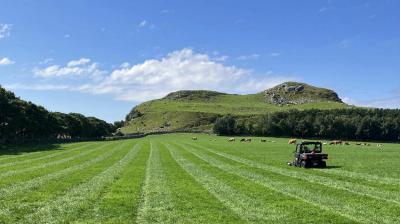 Klosterøy - Archaeologists from the University of Stavanger have announced the possible discovery of a Viking Age marketplace on the island of Klosterøy in southwestern Norway. Using ground penetrating radar, the team have found evidence of pit houses and the foundations of a three pier-or boathouse near the Utstein Monastery. peaking to ScienceNorway, Associate Professor Håkon Reiersen at the Museum of Archaeology, said: “We have received numerous metal detector finds from Utstein in recent years, including items associated with trade such as weights and coins.” I am therefore not surprised that the results now indicate that Utstein was indeed a marketplace in the Viking Age and early Middle Ages,” added Reiersen. Kristoffer Hillesland from the University of Stavanger’s Museum of Archaeology suggests that pit houses often served as workshops for craftsmanship, with similar examples being found at Tønsberg and Bjørkum in Lærdal. Excavations have also uncovered burial mounds, cooking pits, layers of soil indicative of agriculture, and traces of settlement. According to the researchers, when considering the findings of the pit houses and adjacent structures, in conjunction with the presence of burial mounds and numerous objects associated with trade, it further reinforces the probability of a Viking Age marketplace at Utstein. “While many indicators suggest that this may be a marketplace, we cannot be 100 per cent certain until further investigations are conducted in the area to verify the findings,” Grethe Moéll Pedersen says.
Klosterøy - Archaeologists from the University of Stavanger have announced the possible discovery of a Viking Age marketplace on the island of Klosterøy in southwestern Norway. Using ground penetrating radar, the team have found evidence of pit houses and the foundations of a three pier-or boathouse near the Utstein Monastery. peaking to ScienceNorway, Associate Professor Håkon Reiersen at the Museum of Archaeology, said: “We have received numerous metal detector finds from Utstein in recent years, including items associated with trade such as weights and coins.” I am therefore not surprised that the results now indicate that Utstein was indeed a marketplace in the Viking Age and early Middle Ages,” added Reiersen. Kristoffer Hillesland from the University of Stavanger’s Museum of Archaeology suggests that pit houses often served as workshops for craftsmanship, with similar examples being found at Tønsberg and Bjørkum in Lærdal. Excavations have also uncovered burial mounds, cooking pits, layers of soil indicative of agriculture, and traces of settlement. According to the researchers, when considering the findings of the pit houses and adjacent structures, in conjunction with the presence of burial mounds and numerous objects associated with trade, it further reinforces the probability of a Viking Age marketplace at Utstein. “While many indicators suggest that this may be a marketplace, we cannot be 100 per cent certain until further investigations are conducted in the area to verify the findings,” Grethe Moéll Pedersen says.
CHINE – 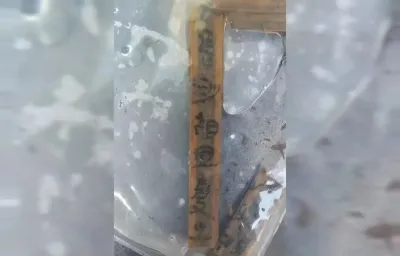 Changsha - Archaeologists have uncovered over 200 fragments of bamboo slips from the Qin and Han Dynasty during excavations in Changsha, China. The slips were discovered in an ancient well at the Chaoyang archaeological site. They are marked in ink using seal script (also known as sigillary script), in addition to clerical script (also known as official script). Seal script was common throughout the latter half of the 1st millennium BC, later used during the Han Dynasty for decorative engraving and official seals. Clerical script evolved from the late Warring States period to the Qin Dynasty, and became dominant during the Han Dynasty. According to the archaeologists, the slips are a government archive that record dates and official positions, the second only example of a cache containing Han Dynasty slips in Changsha following the 2015 discovery at the Huayuan archaeological siteExcavations also found evidence of a rammed earth building and foundations dating to the Western Han Dynasty, and a second well from the Song and Yuan Dynasties in which copper and bronze wares were uncovered. The rammed earth building measures 28 metres by 18 metres, in which the researchers found Western Han Dynasty tube tiles, slab tiles, and moiré tiles in the upper rammed earth. According to the researchers, the building likely belonged to a high status individual such as a city official or aristocrat. Furthermore, alongside the ongoing excavation of stone projectiles launched by the Yuan army during their assault on Changsha during the Southern Song Dynasty, the team have found significant cultural artefacts spanning from the Warring States Period to the Ming and Qing Dynasties. Of particular note are the extensive wooden trenches bearing distinct Changsha characteristics, dating from the Five Dynasties to the early Northern Song Dynasty found to the west of the excavation site.
Changsha - Archaeologists have uncovered over 200 fragments of bamboo slips from the Qin and Han Dynasty during excavations in Changsha, China. The slips were discovered in an ancient well at the Chaoyang archaeological site. They are marked in ink using seal script (also known as sigillary script), in addition to clerical script (also known as official script). Seal script was common throughout the latter half of the 1st millennium BC, later used during the Han Dynasty for decorative engraving and official seals. Clerical script evolved from the late Warring States period to the Qin Dynasty, and became dominant during the Han Dynasty. According to the archaeologists, the slips are a government archive that record dates and official positions, the second only example of a cache containing Han Dynasty slips in Changsha following the 2015 discovery at the Huayuan archaeological siteExcavations also found evidence of a rammed earth building and foundations dating to the Western Han Dynasty, and a second well from the Song and Yuan Dynasties in which copper and bronze wares were uncovered. The rammed earth building measures 28 metres by 18 metres, in which the researchers found Western Han Dynasty tube tiles, slab tiles, and moiré tiles in the upper rammed earth. According to the researchers, the building likely belonged to a high status individual such as a city official or aristocrat. Furthermore, alongside the ongoing excavation of stone projectiles launched by the Yuan army during their assault on Changsha during the Southern Song Dynasty, the team have found significant cultural artefacts spanning from the Warring States Period to the Ming and Qing Dynasties. Of particular note are the extensive wooden trenches bearing distinct Changsha characteristics, dating from the Five Dynasties to the early Northern Song Dynasty found to the west of the excavation site.
ISRAEL – 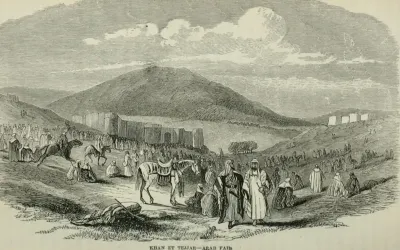 Beit Keshet - During excavations near Beit Keshet in Lower Galilee, Israel, archaeologists from the Israel Antiquities Authority (IAA) have uncovered traces of a market within the historic Khan al-Tujjar caravanserais. Khan al-Tujjar, meaning “merchants caravanserais”, was a resting and meeting place for merchants travelling on the trading routes between Damascus and Cairo, and between Transjordan and Acre. Typically, a caravanserais functioned as a hostel and market, supporting the flow of commerce, information, and people as they journeyed across the network of trade routes covering Asia, North Africa and Southeast Europe, most notably the Silk Road. The caravanserais at Khan al-Tujjar was founded during the late 16th century by Grand Vizier Sinan Pasha, an Albanian-born statesman who served five times as Grand Vizier until his death. Describing Khan al-Tujjar, the Ottoman traveller, Dervish Mehmed Zillî, said: “It is a square, perfect fortress, built of masonry in the midst of a large, verdant meadow. It has a circumference of six hundred paces. The garrison consists of a warden and 150 men. It has a ‘double’ iron gate facing north.” Located within Khan al-Tujjar was the Mosque of Sinan Pasha, an ornately decorated structure decorated with light blue glass enamel and rock crystal. Towering above the mosque was three minarets and seven tall domes. Recent excavations have uncovered a compacted layer of soil containing numerous finds from the Mamluk and Ottoman periods (15th–18th centuries). According to IAA archaeologists, the finds provide a rare glimpse into the merchant market that functioned for centuries in the area between an adjacent fort and the khan. The team found traces of animal bones belonging to dogs, horses, camels, sheep and cattle, indicative of the livestock industry and animal trading which is corroborated in a mid-19th century account by W. M. Thomson, an American Protestant missionary who worked in Ottoman Syria. In addition, a large number of ceramic smoking pipes were found, which historical sources recount on how merchants would sit at shop entrances drinking coffee and smoking pipes. Edna Amos-Dalali, the excavation director on behalf of the Israel Antiquities Authority, said: “The excavation also uncovered a variety of pottery vessels, some made locally, and others imported from regions such as Syria, Turkey, Italy, and China, alongside finds such as rings and jewellery. These finds provide material evidence of the large market that operated at the site.”
Beit Keshet - During excavations near Beit Keshet in Lower Galilee, Israel, archaeologists from the Israel Antiquities Authority (IAA) have uncovered traces of a market within the historic Khan al-Tujjar caravanserais. Khan al-Tujjar, meaning “merchants caravanserais”, was a resting and meeting place for merchants travelling on the trading routes between Damascus and Cairo, and between Transjordan and Acre. Typically, a caravanserais functioned as a hostel and market, supporting the flow of commerce, information, and people as they journeyed across the network of trade routes covering Asia, North Africa and Southeast Europe, most notably the Silk Road. The caravanserais at Khan al-Tujjar was founded during the late 16th century by Grand Vizier Sinan Pasha, an Albanian-born statesman who served five times as Grand Vizier until his death. Describing Khan al-Tujjar, the Ottoman traveller, Dervish Mehmed Zillî, said: “It is a square, perfect fortress, built of masonry in the midst of a large, verdant meadow. It has a circumference of six hundred paces. The garrison consists of a warden and 150 men. It has a ‘double’ iron gate facing north.” Located within Khan al-Tujjar was the Mosque of Sinan Pasha, an ornately decorated structure decorated with light blue glass enamel and rock crystal. Towering above the mosque was three minarets and seven tall domes. Recent excavations have uncovered a compacted layer of soil containing numerous finds from the Mamluk and Ottoman periods (15th–18th centuries). According to IAA archaeologists, the finds provide a rare glimpse into the merchant market that functioned for centuries in the area between an adjacent fort and the khan. The team found traces of animal bones belonging to dogs, horses, camels, sheep and cattle, indicative of the livestock industry and animal trading which is corroborated in a mid-19th century account by W. M. Thomson, an American Protestant missionary who worked in Ottoman Syria. In addition, a large number of ceramic smoking pipes were found, which historical sources recount on how merchants would sit at shop entrances drinking coffee and smoking pipes. Edna Amos-Dalali, the excavation director on behalf of the Israel Antiquities Authority, said: “The excavation also uncovered a variety of pottery vessels, some made locally, and others imported from regions such as Syria, Turkey, Italy, and China, alongside finds such as rings and jewellery. These finds provide material evidence of the large market that operated at the site.”



